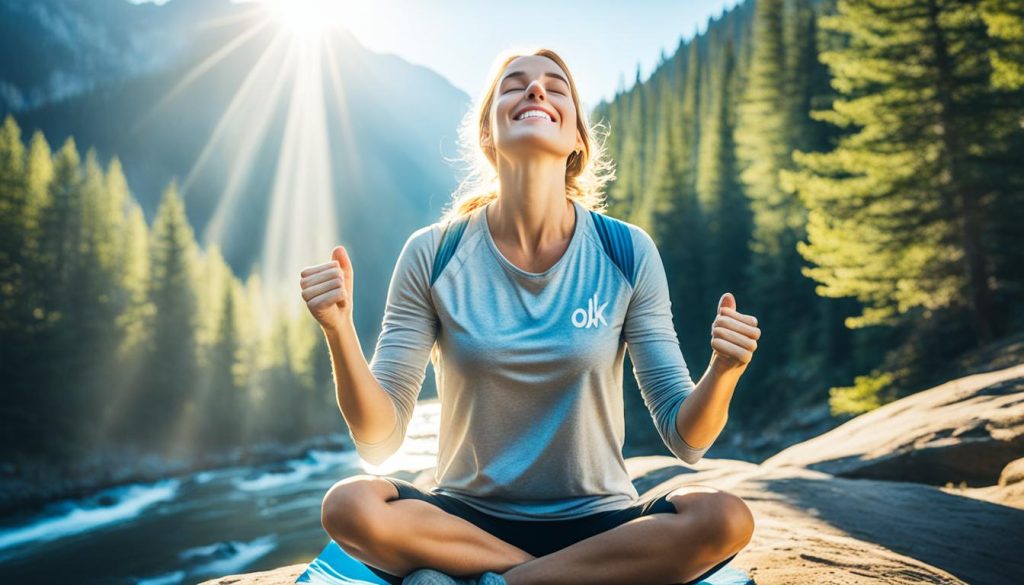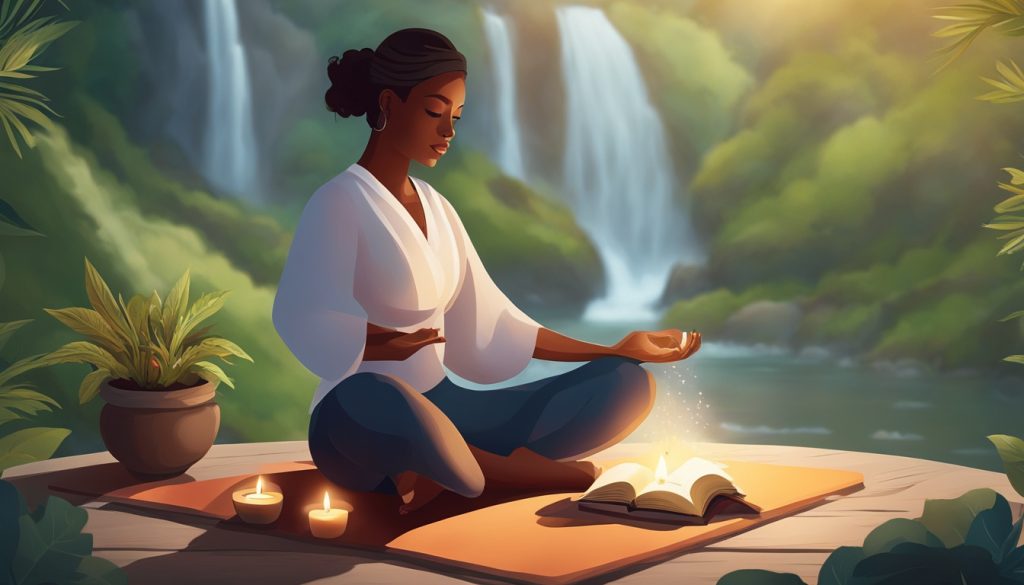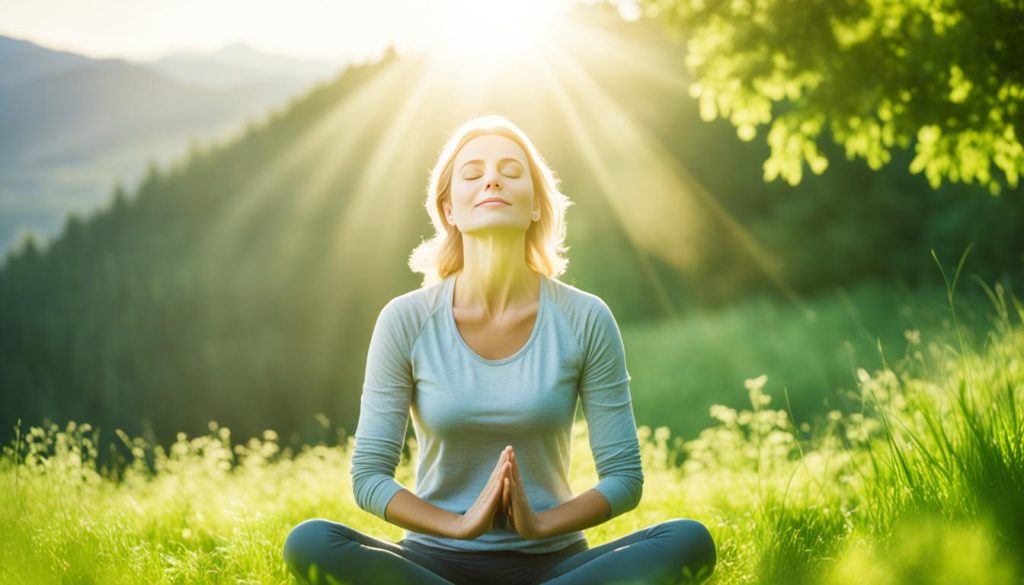Amid today’s fast-paced world, finding inner peace can seem daunting. But, it’s readily achievable. To gain this peace amidst chaos, you need the right tools. These tools come in handy whether you’re too busy, facing tough times, or seeking harmony in life.
Think back to a time when you felt truly calm and happy. Perhaps it was a walk in the park or a quiet moment alone. This inner peace isn’t rare; you can make it a part of your day-to-day life.
Key Takeaways:
- Inner peace is not just for the privileged few, it’s accessible to everyone.
- Simple “micro-practices” can help you find calm amidst the chaos of daily life.
- Your breath, mindfulness, and self-compassion are powerful tools for unlocking inner peace.
- Connecting with nature, practicing gratitude, and cultivating positive relationships can also foster inner tranquility.
- With the right mindset and techniques, you can discover the peace of mind you’ve been seeking.
What is Inner Peace?

Inner peace is a deep state of being truly okay. It’s feeling calm, peaceful, and content. Inner peace is finding a perfect balance and harmony in life.
This peaceful state lets you enjoy good times and manage the bad without stress. It’s like walking a tightrope but feeling safe and happy on it.
Key Attributes of Inner Peace
The hallmarks of inner peace include being:
- Peaceful
- Calm
- At ease
- Comfortable
- Harmonious
- Balanced
- Settled
- Content
- Stable
- Satisfied
- Tranquil
- Secure
Having inner peace means facing life’s swings with grace. You stay grounded during rough times.
“Peace is not something you wish for; it is something you make, something you do, something you are, and something you give away.” – Robert Fulghum
The definition of inner peace and its characteristics are crucial. They help us on the journey to this life-changing state.
Mindfulness: The Key to Inner Peace

Mindfulness helps you be fully present and aware. It lets you watch your thoughts and feelings without judgment. This leads to a calm and balanced mind. Living in the present brings more peace and inner harmony.
Research shows that mindfulness lowers stress, anxiety, and depression. This leads to a better quality of life. Being mindful helps you deal with tough emotions and events without stress.
Adding mindfulness to your day can bring inner peace. You can do simple things like taking deep breaths or noticing your surroundings. Meditation also helps your mind focus. This way, you stay present and find peace easier.
Not judging yourself or others is a big part of mindfulness. This helps you accept and care for yourself, which leads to inner peace. It also helps you understand and be kind to others.
Mindfulness can fit into anyone’s life. You can try meditations, journaling, or just focus on your breathing. With practice, it becomes a powerful way to find inner peace.
“All emotions have a beginning, middle, and end—all within ninety seconds from when they first arise.” – Neuroscientist Jill Bolte Taylor
Being mindful can prevent an “amygdala hijack.” This is when emotions cause a temporary drop in IQ. It helps keep your thoughts clear in tough moments. Inner calm supports better relationships and understanding your actions.
Using mindfulness for inner peace is about staying in the now. It helps you become emotionally stable. By being non-judgmental, you can achieve harmony and well-being. Explore different mindfulness practices and start your journey to peace.
Meditation: A Pathway to Inner Peace

Meditation helps us find inner peace. It focuses on calmly observing and accepting our thoughts without reacting. This practice can lead to a peaceful state of mind. By meditating regularly, you can find peace and serenity within yourself.
Benefits of Meditation
Meditation offers many benefits that enhance our peace of mind. It can:
- Make you feel calmer and more relaxed
- Help you focus better
- Decrease stress and anxiety
- Improve how you handle your emotions
- Help lower blood pressure, heart rate, and cholesterol
- Strengthen your immune system and boost well-being
- Give you a better understanding of yourself
- Make you more resilient to life’s challenges
It has been used for centuries by many cultures and faiths. It’s not only a way to understand yourself better. It’s also a journey towards creativity and feeling connected to everything.
| Meditation Technique | Cultural Origin | Key Focus |
|---|---|---|
| Mindfulness Meditation | Buddhism | Being aware of the present moment without judging |
| Mantra Meditation | Hinduism and Yoga | Repeating a sacred word or phrase for calm |
| Loving-Kindness Meditation | Buddhism | Inspiring love and kindness for ourselves and others |
| Vipassana Meditation | Buddhism | Gaining insight into reality and the self |
Everyone, from beginners to advanced meditators, can find peace through meditation. Start with just 5-10 minutes daily in a quiet space. You can also use guided meditations. This simple habit will open the door to inner calm and understanding.
“Meditation is not about becoming a different person, a new person, or even a better person. It is about training in awareness and getting a healthy sense of perspective. You’re not trying to improve or change yourself, you’re just trying to wake up and have a healthy relationship.” – Jon Kabat-Zinn
Living in the Present Moment

One key to finding peace is to live in the present moment. Instead of thinking about the past or future, focus on what’s happening now. This way, you can feel calm and happy. Being mindful helps with this. Mindfulness means paying attention to now without judging it.
Focus on simple things to feel present. When eating, walking, or doing chores, really pay attention. Notice the details in what you see, hear, and feel. This breaks the habit of worrying and thinking too much.
Using tech less can lower stress. People who use their phones a lot tend to feel bad in their free time. By cutting back on checking emails, students relax more. So, less tech use can make you feel better.
Meditation makes you happier and less anxious. It also strengthens your immune system. Being out in nature lowers stress. It also makes you feel less lonely and more peaceful.
Staying present frees you from stress and worry. Focus on the world around you each day. This will help you find the peace you want.
“The secret of health for both mind and body is not to mourn for the past, not to worry about the future, but to live in the present moment wisely and earnestly.” – Buddha
Cultivating a Positive Mindset

Getting a positive thinking mindset is key to inner peace. It helps you face life’s hurdles calmly and with wisdom. Start your mornings by jotting down things you’re thankful for or look forward to. Turn any negative thoughts into positive ones.
Being kind to yourself and noticing your strong points boosts your joy. More than 70% of people felt happier after spotting their bad thoughts. Changing to a positive view can make life more peaceful.
“The greatest weapon against stress is our ability to choose one thought over another.” – William James
Thankfulness can change your life for the better, too. Research found that 65% felt less negative by thanking daily. Find a little time to praise your life’s simple joys. It can really change how you see things.
Hanging out with positive friends also helps. Studies say a good social circle keeps your mood sunny. Build friendships with those who lift you up and avoid those who drag you down.
Finally, keeping a positive mindset is a big step towards peace. By focusing on good things, thanking, and being with positive people, your life can get happier. It’s all about your attitude.
Developing Self-Love and Acceptance

Learning to love and accept yourself is key to finding peace within. Appreciate your strengths and embrace your flaws. Imagine how your best friend would see your positive qualities. This helps build a peaceful relationship with yourself. Be kind to yourself to grow self-love and self-acceptance.
Embracing Your Uniqueness
Valuing your unique traits and talents is crucial for inner peace. Our world often focuses on what we achieve externally. But it’s vital to love and accept who we are. Understanding your emotions and being aware of yourself brings real peace and well-being.
“The journey to self-love is transformative and empowering, requiring courage and strength to navigate societal expectations and embrace one’s worthiness.”
Some find it hard to connect with their emotions and trust others. Ignoring your feelings can lead to shame and limit what you can achieve. Yet, your feelings can guide you back to peace and wisdom.
Celebrate your unique qualities and strengths. This helps build strong self-love and self-compassion. It changes how you see societal norms and reminds you of your true value. This leads to a happier, more content life.
- Think about what you like about yourself.
- Act towards yourself as kindly as you would towards a friend.
- Find peace by connecting with your feminine side and quiet moments.
- Let yourself feel emotions. They are important signs to inner peace and wisdom.
- Be true to yourself even if it goes against what society expects.
Building self-love and self-acceptance is a life-changing process. It leads to deep inner peace. By valuing what makes you unique and showing kindness to yourself, you live a life true to your best self.
The Importance of Self-Care

Self-care is key to finding happiness and balancing your life. It’s crucial to look after your body and mind. This isn’t a bonus; it’s something you truly need. Regular self-care helps you cope with stress, stay energized, and feel at peace.
Research shows that taking care of yourself can cut anxiety and depression. It makes you more focused, less annoyed, and happier. Physically, it lowers your heart and cancer risks. It also makes you more energetic and your immune system stronger.
Things like working out, sleeping enough, and eating well do wonders for you. They improve both your physical and mental health. Plus, looking after yourself makes your relationships better. When you’re emotionally well, you can be there for others more.
Choosing self-care means you’re looking after your future. It stops you from burning out. It keeps your stress in check and your energy high. Self-care isn’t something extra. It’s a must for a good life. Find what self-care means to you. Put it into practice every day.
“Self-care is not selfish. You cannot serve from an empty vessel.” – Eleanor Brownn
Visualization for Inner Peace

Learn to find peace deep within through guided visualization. This practice lets you imagine a peaceful place that calms you when life gets chaotic.
Close your eyes and picture a place that makes you feel at peace. It might be a quiet beach, a green forest, or a small cabin. Let your mind dive into this world, feeling its calm and joy.
Doing this often can change how you feel and think. You’ll get better at facing tough times with a peaceful mind. The more you do this, the stronger your peaceful feelings become.
“Visualization is the key to creating the life you want.” – Shakti Gawain
When stress hits, close your eyes and go to your peaceful place in your mind. Focus on what makes this place calm, its sounds, sights, and feel. Let yourself be wrapped in its serenity.
Keep at it, and you’ll learn to find deep peace. This will boost your self-awareness, help you manage feelings, and make you healthier. Start now and change your life for the better.
The Benefits of Visualization Meditation
- Reduces stress and anxiety levels
- Strengthens the mind-body connection
- Enhances cognitive function and creativity
- Promotes emotional well-being and resilience
- Supports overall physical health and immune system
Use guided visualization to reach inner peace. Spend a little time each day in your peaceful place. See how it helps you be happier and healthier.
Breathing Exercises for Serenity

In our search for calm, our breath is vital. To unlock deep peace, practice conscious breathing. Breathing exercises in your routine will bring a serene state.
The Healing Power of Breath
Your breath can calm you deeply. Try the 4-7-8 breath: breathe in 4, hold 7, breathe out 8. This helps your body relax. Its long exhale brings inner calm.
Other exercises, like square breathing and resonant breathing, reduce anxiety. They match your breath to your heart, fostering peace.
Adding mindfulness boosts breathing’s effects. Pay attention to each breath. This raises self-awareness and brings peace.
Focusing on breath improves your peace. Find deep breathing, breath control, and relaxation techniques. Enhance peace daily this way.
Regular practice leads to big changes. Connecting with your breath brings deep calm. This helps face life’s challenges with more strength.
Connecting with Nature
Spending time in nature can help you find peace inside. The calming effects of green spaces or just looking at the sky can quiet your mind. This makes you feel calm and peaceful. Being in nature lets you live fully in the present, away from daily stress.
A leisurely walk, tending plants, or just looking around can change how you feel. It helps you find inner peace. Research shows that being in nature is really good for our health, both mentally and physically.
“Allowing downtime to build emotional endurance can significantly impact overall well-being. Mindful thinking, through spending time in nature and being present in the moment, can positively impact mental health and outlook on life.”
A study found that patients could leave the hospital sooner if they saw trees from their window. They had fewer problems and needed less pain medicine. Also, a study in Chicago found that people living near trees were happier and felt better about their home.
Being in nature offers grounding and nature therapy. It’s about being surrounded by the outdoors. The soothing sound of wind or the bright colors of flowers can calm you. Nature refreshes your soul and brings back peace.
So, break from your normal routine and go outside. Enjoy what nature has to give. It’s a chance to reconnect and find the magic of connecting with nature.
Practicing Gratitude for Inner Peace
Feeling gratitude deeply can make you calmer inside. Instead of thinking about what’s wrong, focus on what you’re thankful for. This change in focus can make you happier and more at peace. Writing three things you’re grateful for each day can make a big difference.Then, try to be thankful in the moment. Smile when you wake up. Enjoy the small good things all day.
Seeing the good around you can really change your life for the better. Being thankful has many good effects on your mind and body. This includes making the brain work better and helping the heart and the immune system. This shows that gratitude is truly good for you.
Adding gratitude to your daily life is easy and helpful. Start and end your day with thankfulness. This simple routine can turn your focus to the good you have. It leads to a more positive and peaceful mind.
“Gratitude can transform common days into thanksgivings, turn routine jobs into joy, and change ordinary opportunities into blessings.” – William Arthur Ward
Always remember, you get to choose how you use your time. Making gratitude regular opens the door to a peaceful life.
Starting your gratitude journey is simple. Just take two minutes each day to list what you’re grateful for. Use a journal. This daily habit will make you more positive. You’ll feel happier and more content every day.
Acceptance and Non-Judgment
Learning to accept and not judge is key to finding peace inside. When you just observe your thoughts and feelings without putting a label on them, you open up room for equanimity and insight. This approach makes it easier to deal with tough times by accepting your feelings.
Being less judgmental towards yourself and others can lift the weight of criticism. It helps you to be kind and understanding. This way of thinking brings deep freedom and calm, teaching you to let go of what you can’t change.
It’s important to keep working on acceptance and non-judgment. It’s not a one-time thing but a part of a holistic view of life. By treating yourself and others with care, you build stronger connections with the world.
“The greatest gift you can give yourself is to embrace the present moment with non-judgment and equanimity. This is the path to true inner peace.”
Practicing mindfulness and meditation helps you look at your thoughts from a distance. This way, you can face challenges with more insight and strength, not just reacting as you always do.
The journey to accept and not judge is really about trusting the process and letting go. By doing so, you find a deeper sense of peace and joy. This positive change impacts everything in your life, from friends to happiness.
Peace isn’t found in being perfect, but in loving your imperfections. Start this journey with an open heart. The benefits of becoming more accepting are life-changing.
Building Meaningful Connections
Finding true connections can really help us find inner peace. Being with people who uplift us brings joy and comfort. This joy and comfort are a key part of feeling like we truly belong, bringing us peace.
It’s vital to spend quality time with those we love. This creates a steady support network. A support network that understands us makes us feel at ease. This ease leads to accepting ourselves more, which then adds to our inner peace.
Studies have discovered a link between focusing on what truly fulfills us and being happy. Those who spend time on meaningful relationships are happier than those chasing wealth. Thus, building meaningful connections directly impacts our joy and peace.
“The deepest craving of human nature is the need to be appreciated.” – William James
It’s important to nurture relationships that offer joy and support. This could be by catching up with old friends or joining a group. By fostering these connections, we take a big step towards the peace we desire.
Don’t underestimate the power of your social support. It’s crucial on your path to peace. Investing in these relationships can make your life richer. It helps you find deeper peace and happiness within.
Find Inner Peace Today
Inner peace is like a journey, not a place you reach. You can start by using the tips and practices in this article every day. This will help you feel more calm, balanced, and in harmony. It’s important to know that finding inner peace is different for everyone and it’s a process that never really ends.
Try out different things like meditation, mindfulness, self-care, and being grateful. See which ones you like the most. Keep at it, and slowly but surely, you’ll find what brings you peace. Doing so will have amazing effects on your life.
- Give meditation a chance. Just 40-45 minutes of mindfulness each day can boost your mental health.
- Work on being positive. Thankfulness and staying in the now can make your life fulfilling and joyful.
- Take good care of yourself. Healthy eating and moving your body will make you healthier and more peaceful.
- Love and accept yourself. Celebrate what makes you unique and connect deeply with others. This will help you find peace inside.
- Take a break from social media and devices. Too much screen time can disturb your peace. So, try to limit it.
“The greatest weapon against stress is our ability to choose one thought over another.” – William James
The path to inner peace is unique to each of us. Use these practical tips and suggestions in your life. They will help you live a more harmonious and fulfilling life every day.
Conclusion
In today’s world, finding inner peace is more important than ever. We’ve seen big social and political changes. The pandemic made it clear we need new ways to stay balanced and strong.
By trying things like mindfulness, meditation, and loving yourself, you can find peace. It’s not about avoiding life’s struggles. Instead, it’s learning to face them calmly and gracefully. This way, you make your life and those around you better.
Finding peace is a personal journey that needs patience and practice. Believe that peace is something you can achieve. Know that every small step counts. By being kind to yourself, inner peace can lead you to a more joyful and fulfilling life.
FAQ
What is inner peace and how can it be achieved?
How does mindfulness help in finding inner peace?
What are the benefits of meditation for inner peace?
How can living in the present moment contribute to inner peace?
What is the role of a positive mindset in finding inner peace?
How can self-love and acceptance contribute to inner peace?
Why is self-care important for inner peace?
How can visualization techniques help in finding inner peace?
What are the benefits of breathing exercises for inner peace?
How does connecting with nature contribute to inner peace?
What is the role of gratitude in finding inner peace?
How can acceptance and non-judgment contribute to inner peace?
How do meaningful connections with others contribute to inner peace?
Source Links
- How to Find Inner Peace in Chaotic Moments
- How to Find Inner Peace
- How To Find Inner Peace
- 12 essential mindfulness practices for cultivating inner peace — Calm Blog
- How to Find Inner Peace and Happiness (Incl. Mantras)
- Inner peace
- How Helpful Is Mindfulness To Find Inner Peace For Career Success? – ManagerUp
- Mindfulness A Journey to inner peace
- Inner Calm: The Key is Letting Go
- The Power of Meditation & Mindfulness: A Path to Inner Peace
- If in Doubt, Meditate on Meditation: A Pathway to Inner Peace and Growth
- Meditation: Exploring the Path to Inner Peace and Mindfulness
- Finding Peace in the Present Moment… — Crazy Blonde Life
- Finding Peace by Staying Present
- How to Live in the Present Moment and Find Inner Peace
- Cultivating a Positive Mindset
- Embracing Positivity: A Guide to Cultivating a Positive Mindset
- Learn how to cultivate inner peace amid outer turmoil
- Find Inner Peace through Self-Acceptance
- “Embracing Change and Finding Inner Peace: The Power of Your Self-Love”
- Embracing Self-Love and Inner Peace: A Journey to Feeling at Home in Our Bodies
- What is Self-Care and Why is it Important For You?
- “Self-care for the soul: Tips and Practices for inner Peace and Joy”
- Cultivating Inner Peace: A Guide – Best Psychiatry, Mental Health Clinic, Top 10 Psychiatrist in Florida
- A Visualization For Inner Peace And Happiness – Achieving Self-Compassion
- A Peaceful Place Meditation
- The Benefits of Visualization Meditation: A Guide to Unlocking Your Inner Peace
- Finding Serenity Within: Mastering Mindfulness and Breathing for Lasting Calm — Bridge Counseling – Mental Health support
- Breathing Techniques: 5 breathing techniques that promote calmness and peace from within
- The Power of Serenity: Harnessing Meditation and Breathing Techniques for Inner Peace
- How To Find Inner Peace In Nature And Be Happy
- Finding Inner Peace and Calmness by Connecting With Nature – A Two Drink Minimum
- Nature’s Path to Inner Peace
- Practice Gratitude Daily | Rise … Love … Live
- Why gratitude helps you find inner peace – Karin Sieger – Online Psychotherapy
- Experiencing True Inner Peace | The Gratitude Experiment
- How To Be Non-Judgemental With Negative Thoughts? — InnerPeaceNow.com
- How To Let Go: Non-Judgment And Acceptance Tips
- Embracing Freedom: The Power of Acceptance and Non-Judgment
- Creating an Inner Peace That Endures
- How I found peace and healing by nurturing my inner artist and relationships
- Inner Peace VS Happiness
- How to Find Your Inner Peace
- Find Your Inner Peace and Mental Calm
- 15 Ways to Achieve Inner Peace
- How to Find Inner Peace & Life Balance in Times of Crisis | Dr. Paul Wong
- Finding Inner Peace Amidst Constant Change





